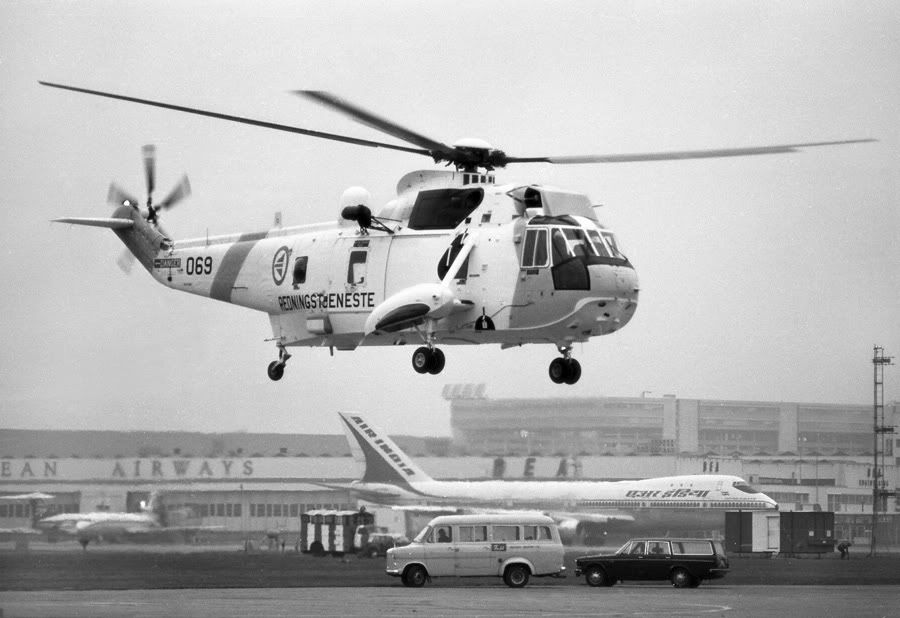The Rotary Nostalgia Thread
There was a certain elegant simplicity to some of the earlier 206 paint schemes. G-BAML on low skids with a simple black (or dark blue) and white paint job looks refreshing again.
Thread Starter
Early JetRanger Paint Schemes
Yes the early schemes weren't bad. That particular scheme was (to the best of my knowledge) Bell's original production pattern (adopted by Agusta). As Agusta stuck with this layout Bell modified theirs (examples below):

The 'Agusta' scheme (adopted from Bell's initial production run) was maintained throughout Agusta's deliveries of 206's. Ferranti adopted the scheme in 'Dijon yellow' for their JetRanger fleet with accents in chocolate
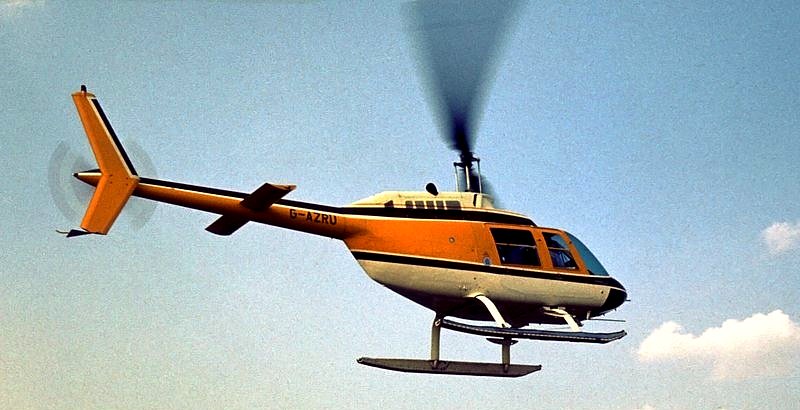
Bell's second scheme seen here on Lord Hanson's private mount G-AZRU
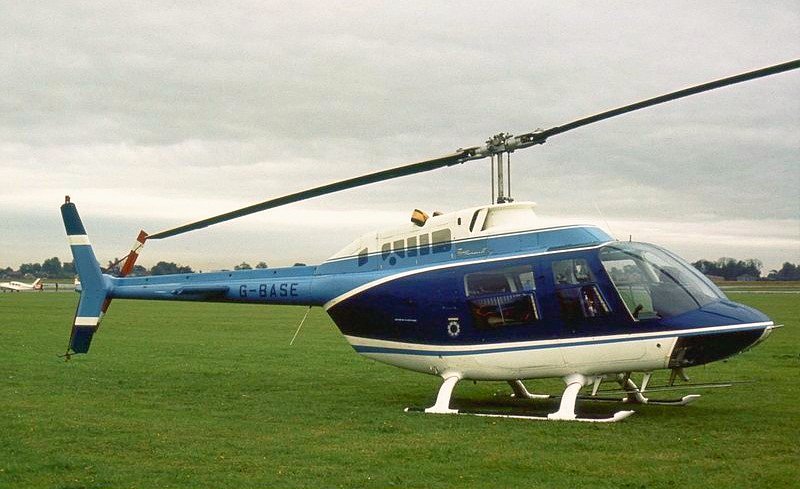
Another popular Bell scheme was seen on Tommy Sopwith's 206 G-BASE

The 'Agusta' scheme (adopted from Bell's initial production run) was maintained throughout Agusta's deliveries of 206's. Ferranti adopted the scheme in 'Dijon yellow' for their JetRanger fleet with accents in chocolate

Bell's second scheme seen here on Lord Hanson's private mount G-AZRU

Another popular Bell scheme was seen on Tommy Sopwith's 206 G-BASE
Join Date: Mar 2011
Location: Holmfirth, UK
Posts: 14
Likes: 0
Received 0 Likes
on
0 Posts
I'm humbled posting in such company having almost - but not quite - a PP(H).
However the post on G-BAML is interesting and reminded me of a motoring journalists dinner I attended a few years back in Birmingham.
The 'Spy Who Loved Me' came up in conversation with a few chaps from Lotus when I explained how the Jet Ranger/Esprit scene in the movie kicked off a passion and resulted in my buying an Esprit at the tender age of 19 to the horror of my parents. (And 25 years later a 206 B3.)
The chap who I was speaking to happened to be none other than Roger Becker the stunt driver in the 1977 film. He'd been sent to Sardinia by Colin Chapman in 1976, since the original United Artists stunt driver hadn't driven a right hand drive mid engined supercar and was making a complete hash of it.
Becker recalled the scene where the Jet Ranger was hovering above the road as he rounded a sweeping bend. His exact words cannot be printed here but suffice it to say he had'nt expected Crewdson to be so low
However the post on G-BAML is interesting and reminded me of a motoring journalists dinner I attended a few years back in Birmingham.
The 'Spy Who Loved Me' came up in conversation with a few chaps from Lotus when I explained how the Jet Ranger/Esprit scene in the movie kicked off a passion and resulted in my buying an Esprit at the tender age of 19 to the horror of my parents. (And 25 years later a 206 B3.)
The chap who I was speaking to happened to be none other than Roger Becker the stunt driver in the 1977 film. He'd been sent to Sardinia by Colin Chapman in 1976, since the original United Artists stunt driver hadn't driven a right hand drive mid engined supercar and was making a complete hash of it.
Becker recalled the scene where the Jet Ranger was hovering above the road as he rounded a sweeping bend. His exact words cannot be printed here but suffice it to say he had'nt expected Crewdson to be so low

In addition to some of the posts on page 47 relating to Australian B206s and H500s in the Antarctic, here is a link to an interesting piece which features a well-known PPRuner;
Publication:Semaphore - Issue 18, 2005 - Royal Australian Navy

Thala Dan's helicopter on the make-shift helipad onboard HMAS Hobart
While on the subject of Australian helicopters in the Antarctic, does anybody know the identity of the Jayrow Hughes 500 that suffered a dynamic roll-over down south? Thanks.
500 Fan.
Publication:Semaphore - Issue 18, 2005 - Royal Australian Navy

Thala Dan's helicopter on the make-shift helipad onboard HMAS Hobart
In the meantime, the antarctic support vessel MV Thala Dan was only twelve hours steaming from the port of Hobart. The Thala Dan was directed to put into Hobart, disembark her passengers and take on a helicopter chartered by the Antarctic Division to assist in the rescue.
The following day, Hobart established direct communications with Macquarie Island and a full medical update on Mr Barker's condition was received. Having fallen from the cliff face, Mr Barker had spent four agonising hours lying on his stomach trying to stop skuas from pecking at his injuries before he was rescued.[1] Grave concerns were held for his well being and it was unclear what the best method of transferring him to Hobart would be, in light of deteriorating weather conditions at Macquarie Island.
On Sunday 7 January a three way communications link was established between Hobart, the Thala Dan, and the Macquarie Island base. Transfer options were discussed with the pilot of Thala Dan's small utility helicopter, Nigel Osborn who, as luck would have it, was an ex-Royal Navy pilot. It was agreed that a makeshift helicopter pad should be constructed onboard Hobart to enable transfer of the patient by air in the event that weather conditions at Macquarie Island were unsuitable for a boat transfer.
Throughout the day, Hobart found herself in rapidly deteriorating weather, with a fifteen foot swell running and the wind registering a constant force seven (28-33 knots). A number of her crew, particularly those who had been seconded for the voyage and who were not accustomed to the pitching and rolling of a DDG, experienced great discomfort as the ship steamed steadily south. In spite of this, the destroyer's shipwrights, engineers and seamen commenced work on the construction of the helicopter pad on the port side of Hobart's quarterdeck, using only the material and expertise available onboard. By the end of the day they had skilfully assembled a stout platform and were reasonably confident that it would be capable of receiving Thala Dan's helicopter should the need arise.
At 0515 on Monday 8 January, Macquarie Island was raised on radar and shortly afterwards Hobart altered her course to pass between the Judges and Clerk Islands as she proceeded to rendezvous with Thala Dan in Buckles Bay. On arrival in Buckles Bay at 0854, Hobart anchored two and a half cables to seaward of Thala Dan where an immediate assessment was made on how best to transfer the injured scientist. Hobart was rolling up to 12 degrees with the wind gusting between 30 and 35 knots, while the choppy sea state was estimated to be between three and four feet in height. Notwithstanding the shelter offered within the bay, it was obvious that it would be much too hazardous to attempt a boat transfer and risk further injury to the patient in such conditions. Thus the decision was made to transfer the patient using Thala Dan's helicopter.
Within half an hour Hobart was closed up at 'flying stations' and Thala Dan's helicopter was called in to attempt a trial landing on the recently constructed helipad. The landing was timed to avoid periods of excessive rolling and at 0930 the helicopter landed safely on board the makeshift structure. With the trial complete attention now turned to the medical evacuation of Mr Barker, which began at 1002 following the passing of a heavy rain squall. Again the helicopter was called in and the transfer was successfully completed in approximately 60 seconds.[2] With the patient and an Antarctic Division medical officer safely on board Hobart, the helicopter returned to Thala Dan with the distinction of being the first aircraft to land on board a Perth class DDG.
Hobart weighed anchor without delay and once clear of the island set course at best speed for the 900-mile voyage to Hobart. Mr Barker handled the rough sea conditions well throughout Monday 8 January and the forenoon of the following day; however, concern over a deterioration in his condition necessitated an increase in speed in spite of the weather. The Derwent River was entered at 2340 on Tuesday 9 January and Hobart berthed alongside Macquarie Wharf at 0115 on Wednesday morning, completing the journey in a record 39 hours. Shortly after berthing, Mr Barker was transferred to a waiting ambulance and taken to the Royal Hobart Hospital.
Throughout the transit from Macquarie Island to Hobart, it was reported that the injured Roger Barker displayed great courage and remained composed in spite of his terrible injuries. He underwent emergency surgery on arrival in hospital at Hobart, which sadly resulted in the amputation of his left leg. It was with deep regret that the crew of Hobart later learned that he lost his fight for life when he succumbed to his injuries in Melbourne on 8 February 1979. [3] As a tribute to Roger Barker, the Barker Channel in the Vestford Hills region of Australian Antarctic Territory was subsequently named in his honour. Search here for Barker Channel on the Australian Antarctic Data Centre website
Hobart's mercy dash in 1979 typifies both the character and compassion of the Australian sailor. Her 'scratch' crew's willingness to put service before self to assist someone in great need, coupled with their ability to improvise in the face of adversity continues to serve as a fine example of naval ingenuity.
The following day, Hobart established direct communications with Macquarie Island and a full medical update on Mr Barker's condition was received. Having fallen from the cliff face, Mr Barker had spent four agonising hours lying on his stomach trying to stop skuas from pecking at his injuries before he was rescued.[1] Grave concerns were held for his well being and it was unclear what the best method of transferring him to Hobart would be, in light of deteriorating weather conditions at Macquarie Island.
On Sunday 7 January a three way communications link was established between Hobart, the Thala Dan, and the Macquarie Island base. Transfer options were discussed with the pilot of Thala Dan's small utility helicopter, Nigel Osborn who, as luck would have it, was an ex-Royal Navy pilot. It was agreed that a makeshift helicopter pad should be constructed onboard Hobart to enable transfer of the patient by air in the event that weather conditions at Macquarie Island were unsuitable for a boat transfer.
Throughout the day, Hobart found herself in rapidly deteriorating weather, with a fifteen foot swell running and the wind registering a constant force seven (28-33 knots). A number of her crew, particularly those who had been seconded for the voyage and who were not accustomed to the pitching and rolling of a DDG, experienced great discomfort as the ship steamed steadily south. In spite of this, the destroyer's shipwrights, engineers and seamen commenced work on the construction of the helicopter pad on the port side of Hobart's quarterdeck, using only the material and expertise available onboard. By the end of the day they had skilfully assembled a stout platform and were reasonably confident that it would be capable of receiving Thala Dan's helicopter should the need arise.
At 0515 on Monday 8 January, Macquarie Island was raised on radar and shortly afterwards Hobart altered her course to pass between the Judges and Clerk Islands as she proceeded to rendezvous with Thala Dan in Buckles Bay. On arrival in Buckles Bay at 0854, Hobart anchored two and a half cables to seaward of Thala Dan where an immediate assessment was made on how best to transfer the injured scientist. Hobart was rolling up to 12 degrees with the wind gusting between 30 and 35 knots, while the choppy sea state was estimated to be between three and four feet in height. Notwithstanding the shelter offered within the bay, it was obvious that it would be much too hazardous to attempt a boat transfer and risk further injury to the patient in such conditions. Thus the decision was made to transfer the patient using Thala Dan's helicopter.
Within half an hour Hobart was closed up at 'flying stations' and Thala Dan's helicopter was called in to attempt a trial landing on the recently constructed helipad. The landing was timed to avoid periods of excessive rolling and at 0930 the helicopter landed safely on board the makeshift structure. With the trial complete attention now turned to the medical evacuation of Mr Barker, which began at 1002 following the passing of a heavy rain squall. Again the helicopter was called in and the transfer was successfully completed in approximately 60 seconds.[2] With the patient and an Antarctic Division medical officer safely on board Hobart, the helicopter returned to Thala Dan with the distinction of being the first aircraft to land on board a Perth class DDG.
Hobart weighed anchor without delay and once clear of the island set course at best speed for the 900-mile voyage to Hobart. Mr Barker handled the rough sea conditions well throughout Monday 8 January and the forenoon of the following day; however, concern over a deterioration in his condition necessitated an increase in speed in spite of the weather. The Derwent River was entered at 2340 on Tuesday 9 January and Hobart berthed alongside Macquarie Wharf at 0115 on Wednesday morning, completing the journey in a record 39 hours. Shortly after berthing, Mr Barker was transferred to a waiting ambulance and taken to the Royal Hobart Hospital.
Throughout the transit from Macquarie Island to Hobart, it was reported that the injured Roger Barker displayed great courage and remained composed in spite of his terrible injuries. He underwent emergency surgery on arrival in hospital at Hobart, which sadly resulted in the amputation of his left leg. It was with deep regret that the crew of Hobart later learned that he lost his fight for life when he succumbed to his injuries in Melbourne on 8 February 1979. [3] As a tribute to Roger Barker, the Barker Channel in the Vestford Hills region of Australian Antarctic Territory was subsequently named in his honour. Search here for Barker Channel on the Australian Antarctic Data Centre website
Hobart's mercy dash in 1979 typifies both the character and compassion of the Australian sailor. Her 'scratch' crew's willingness to put service before self to assist someone in great need, coupled with their ability to improvise in the face of adversity continues to serve as a fine example of naval ingenuity.
500 Fan.
Last edited by Senior Pilot; 5th Jan 2012 at 20:31. Reason: Add part of the linked article
Join Date: Dec 2001
Location: Gold Coast, Queensland
Posts: 943
Likes: 0
Received 0 Likes
on
0 Posts
500 Fan
I've no idea where you found that article as I've never seen it before. Roger was a terrific bloke & kept apologizing for messing up everyones holidays! His leg had gone gangrenous & was removed immediately on arrival in Hobart. His broken back was a worry, so he was flown to Melbourne for further treatment. After 3 weeks he had a series of strokes from a blood clot in his leg & tragically after so many peoples efforts, he died.
His parents flew over from Adelaide & got the doctor to drive them to my house to personally thank me & asked me to follow them to the hospital as Roger also wanted to thank me.
I've no idea where you found that article as I've never seen it before. Roger was a terrific bloke & kept apologizing for messing up everyones holidays! His leg had gone gangrenous & was removed immediately on arrival in Hobart. His broken back was a worry, so he was flown to Melbourne for further treatment. After 3 weeks he had a series of strokes from a blood clot in his leg & tragically after so many peoples efforts, he died.
His parents flew over from Adelaide & got the doctor to drive them to my house to personally thank me & asked me to follow them to the hospital as Roger also wanted to thank me.
Join Date: Jul 2010
Location: In the shadows
Age: 80
Posts: 290
Likes: 0
Received 0 Likes
on
0 Posts
Re the query about the ironmongery on the oleos of the Whirlwinds in post #1180, I have heard back from three of the five "elderly pingers" who I emailed. Unfortunately none of them flew Whirlwinds with that bit of kit fitted but they all surmise it was a radar reflector - almost certainly to prevent the helicopter being mown down by a ship whilst the former was in the dip (in the hover with the sonar lowered).
What has come to light from one of them is that the photograph date of c.1963 can be refined. 825 was formerly a Gannet squadron until 1958 and on 16 August 1960 it reformed with the Whirlwind HAS7, embarking on Victorious on 18 October that year. The Squadron stayed on Victorious until the ship's Commission ended and the Squadron disbanded on 2 April 1962. It did not reform until 3 May 1982 when it was hurriedly reformed with Sea Kings from 706 training squadron for the Falklands campaign under the command of my good friend the late Commander Hugh Clark.
The Squadron that was embarked in Victorious in 1963 was 814 and they were equipped with the Wessex HAS1 not the Whirlwind.
Re Geoffers comment about the Mk7 winching itself virtually into the water, I also have vivid memories of that happening to me in Falmouth Bay - during basic flying training with Petty Officer Mitchell as the winchman and a rather hefty "volunteer" as the rescuee. Quite brave of the winchman to entrust himself to winching with a 19 year old "solo" student with only around 70 hours on helicopters!
What has come to light from one of them is that the photograph date of c.1963 can be refined. 825 was formerly a Gannet squadron until 1958 and on 16 August 1960 it reformed with the Whirlwind HAS7, embarking on Victorious on 18 October that year. The Squadron stayed on Victorious until the ship's Commission ended and the Squadron disbanded on 2 April 1962. It did not reform until 3 May 1982 when it was hurriedly reformed with Sea Kings from 706 training squadron for the Falklands campaign under the command of my good friend the late Commander Hugh Clark.
The Squadron that was embarked in Victorious in 1963 was 814 and they were equipped with the Wessex HAS1 not the Whirlwind.
Re Geoffers comment about the Mk7 winching itself virtually into the water, I also have vivid memories of that happening to me in Falmouth Bay - during basic flying training with Petty Officer Mitchell as the winchman and a rather hefty "volunteer" as the rescuee. Quite brave of the winchman to entrust himself to winching with a 19 year old "solo" student with only around 70 hours on helicopters!
Last edited by CharlieOneSix; 5th Jan 2012 at 22:35.
Hi Nigel. I'm glad that link was of interest. I found that story while looking for info on Jayrow's Hughes 500s in the Antarctic.
It's just a great pity your efforts and the efforts of others were not met with a happy outcome on that occasion. If you have other interesting tales of flying in the Antarctic, I, for one, would love to hear them. Thanks.
500 Fan.
It's just a great pity your efforts and the efforts of others were not met with a happy outcome on that occasion. If you have other interesting tales of flying in the Antarctic, I, for one, would love to hear them. Thanks.
500 Fan.
Join Date: Jul 2010
Location: In the shadows
Age: 80
Posts: 290
Likes: 0
Received 0 Likes
on
0 Posts
"Switch off the position lights"
Who remembers the instructor on Hiller 12E's on 705 Squadron who was flying two seaman officers on the air experience Junior Officers Air Course on a mucky day at Predannack - must have been around 1964.
The weather improved and the instructor pointed at the navigation lights switch (labelled as position lights) and said to the centre seat passenger "Switch off the position lights". Unused to a helicopter intercom he heard this as "switch off the ignition" and promptly turned off both magnetos whilst they were at 300 ft downwind. A successful engine off landing followed.
A successful engine off landing followed.
The weather improved and the instructor pointed at the navigation lights switch (labelled as position lights) and said to the centre seat passenger "Switch off the position lights". Unused to a helicopter intercom he heard this as "switch off the ignition" and promptly turned off both magnetos whilst they were at 300 ft downwind.
 A successful engine off landing followed.
A successful engine off landing followed.
Thread Starter
500 Fan: That was a great find on the Osborn rescue .. bravo!
Yoyo: Given the aircraft's titles: "Redningstjeneste" this is most likely a Norwegian SAR bird and which begs the question; what were they doing at Heathrow?


A Royal Navy Westland Sea King HAR5 is joined by a Bond Air Services EC135 at Dunoon, Scotland on 3rd June 2010

Royal Navy Sea King HAR5 XZ920 of HMS Gannet's SAR flight .. in flight .. with the co-jo employing that most rare of aeronautical skills once known as navigation!
And then there's this ..

Details are scarce although there appears to be an '85' stamped on the nose of the craft. Word is that the Navy fly boys were distracted during their sortie by this 'foreign' species and were captured during their interrogation of the same!
Of Bulwark, Whirlwinds and Christmas!
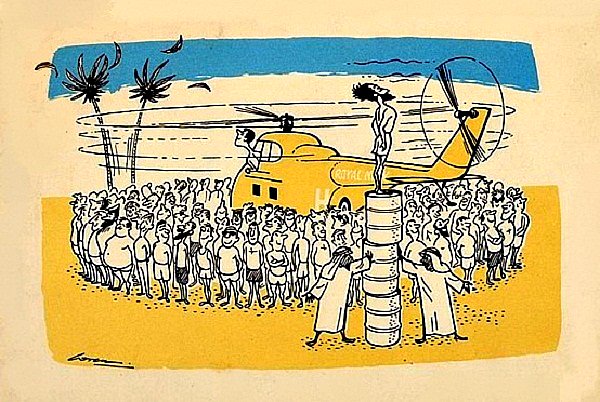
The Christmas card distributed by 848 Helicopter Squadron aboard HMS Bulwark in 1961. Perhaps someone, somewhere, can interpret the significance of the drawing!
Yoyo: Given the aircraft's titles: "Redningstjeneste" this is most likely a Norwegian SAR bird and which begs the question; what were they doing at Heathrow?


A Royal Navy Westland Sea King HAR5 is joined by a Bond Air Services EC135 at Dunoon, Scotland on 3rd June 2010

Royal Navy Sea King HAR5 XZ920 of HMS Gannet's SAR flight .. in flight .. with the co-jo employing that most rare of aeronautical skills once known as navigation!
And then there's this ..

Details are scarce although there appears to be an '85' stamped on the nose of the craft. Word is that the Navy fly boys were distracted during their sortie by this 'foreign' species and were captured during their interrogation of the same!
Of Bulwark, Whirlwinds and Christmas!

The Christmas card distributed by 848 Helicopter Squadron aboard HMS Bulwark in 1961. Perhaps someone, somewhere, can interpret the significance of the drawing!
Last edited by Senior Pilot; 6th Jan 2012 at 07:22. Reason: HAR5, not HU5
Join Date: Sep 2008
Location: Cornwall UK
Age: 79
Posts: 507
Likes: 0
Received 0 Likes
on
0 Posts
Norwegian Sea King Heathrow early 1973
It was pre-delivery, maybe a VIP pick-up or drop-off
1973 | 0805 | Flight Archive sea king heathrow
1973 | 0805 | Flight Archive sea king heathrow
Thread Starter
Ah Bast0n .. what splendiffery are you assaulting us with now!
In post 424 I ramble on about my first ever flight in a helicopter where I wrote:
So, your shot is (for me) just fantastic! Many thanks.

A Manfred Mann 206 carrying-out a photographic assignment with Seaspeed c. 1970's
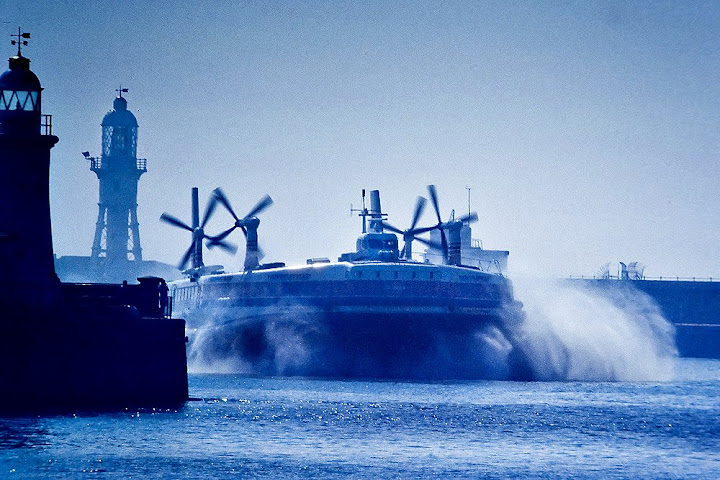
The fabulous SRN4 departing Dover Hoverport
500 Fan, seeing as you dug up the Osborn story; this is for you:


Hughes 500C G-BDFP at Battersea Heliport in 1977 (Photo: Anton Heumann)
Though known for much of her life as G-OAIM this craft started-out as BDFP initially sold to 'Hughes' of Beaconsfield in 1975 but then to remain in the stewardship of John E. Clarke & Co. (Bournemouth) for some 14 years between 1976 and 1990.
In post 424 I ramble on about my first ever flight in a helicopter where I wrote:
Up until that point the only contraption which had captured my imagination was the hovercraft, which I loved, especially Hoverlloyd's red and white beasts.

A Manfred Mann 206 carrying-out a photographic assignment with Seaspeed c. 1970's

The fabulous SRN4 departing Dover Hoverport
500 Fan, seeing as you dug up the Osborn story; this is for you:


Hughes 500C G-BDFP at Battersea Heliport in 1977 (Photo: Anton Heumann)
Though known for much of her life as G-OAIM this craft started-out as BDFP initially sold to 'Hughes' of Beaconsfield in 1975 but then to remain in the stewardship of John E. Clarke & Co. (Bournemouth) for some 14 years between 1976 and 1990.
Join Date: May 2008
Location: Somerset
Age: 81
Posts: 635
Likes: 0
Received 0 Likes
on
0 Posts

This shot of the P1127 trials on board HMS Bulwark off the Cornish coast may amuse those engineers who watch this thread. You may notice that there is an SAR Whirlwind 7 parked just ahead of the island - yup that's me! I went out to photograph the trial as the embarked Wessex 5s are not good for photography as the exhaust blurs shots taken from the cabin. I did one sortie and then needed fuel. I was made most welcome especially as it was a Sunday, and taken down to the ACRB for coffee. After a short while the flight deck engineer appeared and said that they could only get a couple of gallons of Avgas into the tanks so what should he do?
I guessed right away what he had done! The Whirlwind fuel filler cap - marked fuel - is very close to the engine oil filler cap marked oil! Those of you with long memories will remember that there was a one and half gallon airspace in the sump to allow for frothing. The engineers had topped up the sump with fuel. After much head scratching as Bulwark was on her way south west, they drained and refilled the sump with oil - no time to flush - filled up with fuel and off we should have went.
Guess what - the starter cartridge mechanism blew up so no start facility apart from hand swinging all 17 litres of Leonides. It takes 82 turns of the starting handle to turn the engine through one revolution! A team of hefty aircraft handlers lined up to do the necessary - I kept my finger on the high energy ignition button and another on the prime button - and after an eternity it fired on one then three then a few more and eventually was running. We thought it time to return to Culdrose as faces were starting to turn red in FLYCO at the thought of taking a Whirlwind to Gibraltar.
I have a feeling to this day that to fly home without doing all the necessray flushing may have been pushing it a bit............
BastOn,
I wouldn't worry about the diluted oil as long as the engine wasn't run. I had this problem in the Arabian Gulf a few times on the civil turbine Whirlwind on oil rigs.
Each time I just drained the oil/fuel mix and replaced with fresh oil and then flew back to base in the aircraft.
I wouldn't worry about the diluted oil as long as the engine wasn't run. I had this problem in the Arabian Gulf a few times on the civil turbine Whirlwind on oil rigs.
Each time I just drained the oil/fuel mix and replaced with fresh oil and then flew back to base in the aircraft.
Join Date: Sep 2001
Location: In the Haven of Peace
Age: 79
Posts: 600
Received 0 Likes
on
0 Posts
Neddy Seagoon

With reference to the aforementioned Neddy Seagoon, here he is (sans whiskers) when he and I were embarking on our career as aviators.
133HSP, RAF Linton-on-Ouse
Back row - Midshipman Macgregor RN (later chopped), S/Lt Ruppersbury (later chopped, then became an ATCO), 2Lt Brown RM (later transferred to RN, then died in an accident), Lt Randle RN, Lt 'Neddy Seagoon' Seymour RN, 2Lt Evans RM, 2Lt Jeffs RM, Midshipman Goodfellow RN (chopped).
Front Row - P/O Mustaffa RMAF, 2Lt Booth RM (chopped), S/Lt Tookey RN, Lt Grieg RM (chopped), Lt Gratton-Cooper RN, S/Lt Byham RN (chopped), S/Lt Howes RN (chopped, then became an ATCO), P/O Harun RMAF
It seems that only a few of us survived getting our wings and even then a few more fell by the wayside. Even Bast0n almost fell by the wayside once (at least
 ) - or fell out of his Mini Moke by the wayside, but was greeted by his Bassett Hound, who had also survived the journey back from another happy Halzephron evening, with greet delight
) - or fell out of his Mini Moke by the wayside, but was greeted by his Bassett Hound, who had also survived the journey back from another happy Halzephron evening, with greet delight 
Join Date: Sep 2001
Location: In the Haven of Peace
Age: 79
Posts: 600
Received 0 Likes
on
0 Posts
845 NACS at SBAC Farnborough airshow 1968
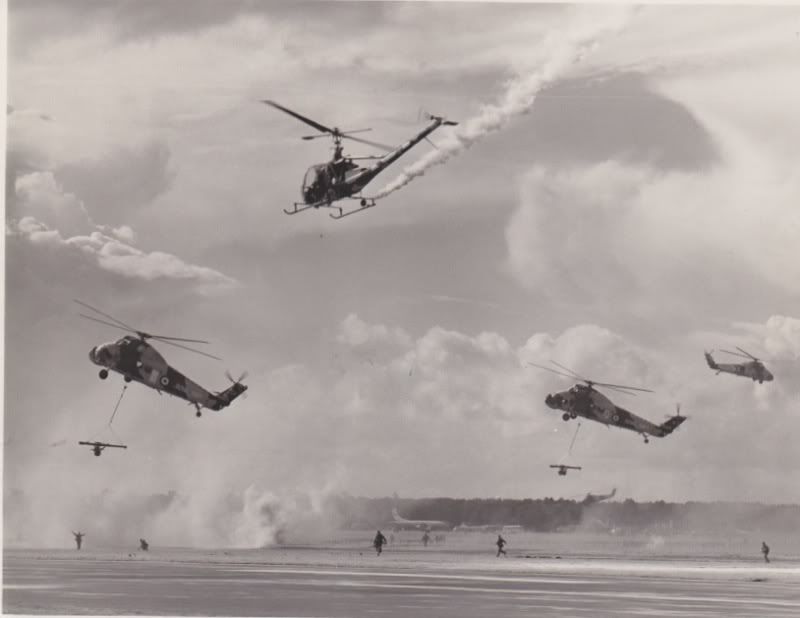
HMS Arethusa encounters a little touch of stormy weather, Iceland 1972
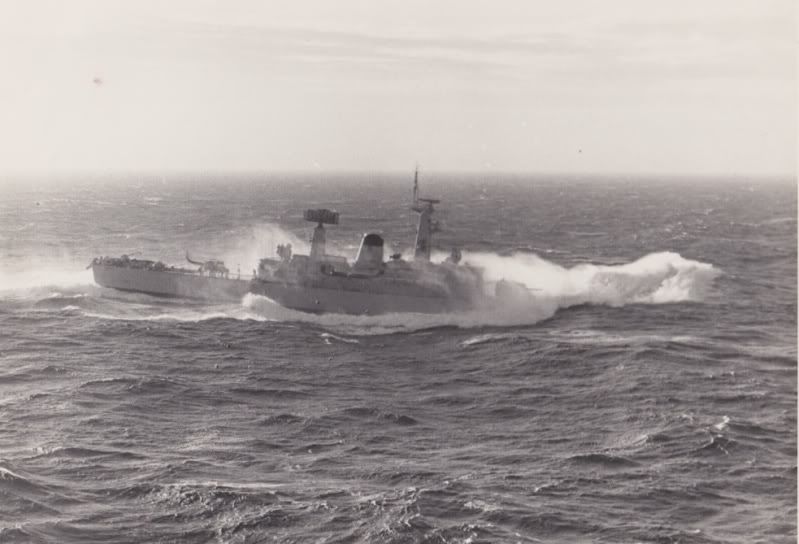
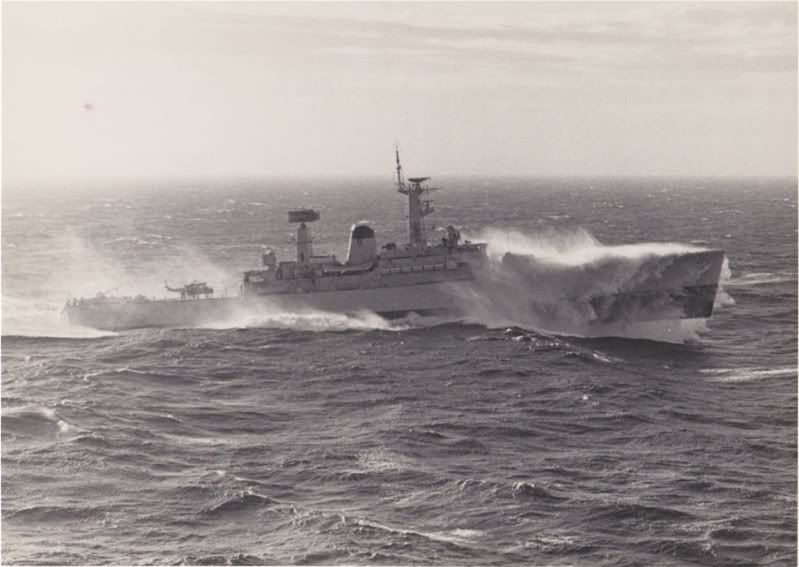
A couple of days before these photos were taken, I was flying around in my Wasp at 400 feet when suddenly I was astonished to see an RAF Nimrod appear from underneath me. It was flying at its normal MAD search height of 200 feet and as we'd removed our radar reflectors (a bit like the ones in your photos of the Whirlwind earlier) to render us less visible to the Icelandic coastguard gunboats, he hadn't seen me. The next time a Nimrod came by a slight swell made us disinclined to fly, so he took these photos of us emulating a submarine and the crew of the original Nimrod were kind enough to drop them off in the next mail container.

HMS Arethusa encounters a little touch of stormy weather, Iceland 1972


A couple of days before these photos were taken, I was flying around in my Wasp at 400 feet when suddenly I was astonished to see an RAF Nimrod appear from underneath me. It was flying at its normal MAD search height of 200 feet and as we'd removed our radar reflectors (a bit like the ones in your photos of the Whirlwind earlier) to render us less visible to the Icelandic coastguard gunboats, he hadn't seen me. The next time a Nimrod came by a slight swell made us disinclined to fly, so he took these photos of us emulating a submarine and the crew of the original Nimrod were kind enough to drop them off in the next mail container.
Thread Starter
Bast0n; what a great story and what fun it must have been in those glorious days of starter cartridges and hand cranks. Brilliant!
Some Bast0n-era memorabilia:

An Auster Starter Cartridge
I tried to find a Whirldwind starting cartridge but, alas, no joy. I'm assuming though that it can't have been too different from the example above, or, perhaps it was?

An Alvin Leonides advert from 1958
The blurb reads: "The Alvis Leonides Major. A 16 cylinder radial engine of exceptionally compact dimensions gives the Westland Whirldwind better load-lifting and hovering ability and increases the height attainable in forward flight."
Soggy: Your shots are wonderful .. many thanks! So which one of this non-motley-crew are you? You seem to have been in the Farnborough environs at the same time as Nigel Osborn (I think). Brilliant to see just how much of Arethusa's bow could get out of the water. Great stuff!
The TSMS Lakonia Disaster
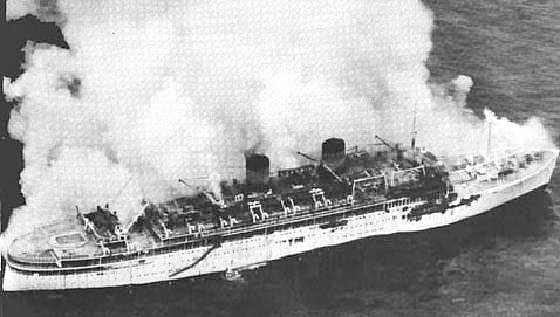
The TSMS Lakonia ablaze on 23rd December 1963

A Royal Navy Westland Whirlwind from the British aircraft carrier HMS Centaur returns to the smouldering Lakonia on 24th December 1963 to lower crewmen who would recover bodies from the charred vessel
Some Bast0n-era memorabilia:

An Auster Starter Cartridge
I tried to find a Whirldwind starting cartridge but, alas, no joy. I'm assuming though that it can't have been too different from the example above, or, perhaps it was?

An Alvin Leonides advert from 1958
The blurb reads: "The Alvis Leonides Major. A 16 cylinder radial engine of exceptionally compact dimensions gives the Westland Whirldwind better load-lifting and hovering ability and increases the height attainable in forward flight."
Soggy: Your shots are wonderful .. many thanks! So which one of this non-motley-crew are you? You seem to have been in the Farnborough environs at the same time as Nigel Osborn (I think). Brilliant to see just how much of Arethusa's bow could get out of the water. Great stuff!
The TSMS Lakonia Disaster
The Lakonia departed Southampton on December 19, 1963 for an 11-day "Christmas Cruise" of the Canary Islands. Her first scheduled stop was to be the island of Madeira. There were 646 passengers and 376 crewmen on board: a total of 1,022 people. All but 21 of the passengers were British citizens, and the crew members were mostly Greek and German. The captain of the Lakonia was 53-year-old Mathios Zarbis.
Fire alarms sounded, but too softly to be heard by most passengers. "The fire alarm bell was so weak that it sounded like someone calling the waiter to ask for tea," one survivor later told reporters. An alarm went off on the bridge, pinpointing the fire’s location. The ship was about 180 miles north of Madeira
At the time the blaze was discovered, most of the passengers were in the ship's ballroom, called the Lakonia Room, dancing at the "Tropical Tramps' Ball." Passengers began to notice the smell of smoke, but most dismissed it as strong cigar smoke. Captain Zarbis, who had been notified of the fire, attempted to make an announcement on the ship's intercom system, but it had been disabled by the blaze. As smoke began to fill the ballroom at about 11:30, the band stopped playing and cruise director George Herbert ushered the frightened passengers to the boat deck. The upper deck was ablaze within 10 minutes.
Many of the passengers who had been asleep in their cabins found themselves unable to escape the fire. Some passengers were told to go to the main dining room to await instructions, but most ignored this order, since the dining room lay directly in the path of the fire.
At 11:30 p.m., the ship's chief radio officer Antonios Kalogridis sent out the first distress call: "Fire spreading up. Prepare evacuation on ship." At midnight, a second distress call was sent out: "We are leaving the ship. Please immediately give us assistance. Please help us." Kalogridis sent out the last call at 12:22 a.m., just before the wireless room caught fire: "SOS from Lakonia, last time. I cannot stay anymore in the wireless station. We are leaving the ship. Please immediate assistance. Please help."
When all of the boats were away, there were still people adrift in the water and over 100 people left on board the burning ship. The Lakonia continued to burn fiercely and was rocked by violent explosions. Those who remained on board flocked to the glass-enclosed Agora Shopping Center at the stern of the ship. After several hours, the flames closed in on them, and they were forced to descend ropes and rope ladders into the ocean. The port and starboard gangways were lowered as well, and people walked down the gangways single file into the sea.
At 3:30 a.m., four hours after the first distress call, the 495-foot (151 m) Argentine passenger ship Salta arrived on the scene. The Salta, under the command of Captain José Barrere, had been on its way from Genoa, Italy to Buenos Aires. The 440-foot (130 m) British tanker Montcalm arrived half an hour later at 4:00 a.m. The majority of the survivors were saved by these two ships. The Salta rescued 475 people and took aboard most of Lakonia's lifeboats.
In the hours that followed, the Belgian ship Charlesville, the Brazilian freighter Rio Grande, the British passenger ship Stratheden and the Panamanian freighter Mehdi all arrived to take part in the rescue. Each of the rescue vessels dispatched boats to pluck survivors from the water. Also, four United States Air Force C-54 planes were sent from the Lajes Air Base in the Azores. The planes dropped flares, lifejackets, life rafts and survival kits to people in the water.
Rescue efforts were hindered by the fact that the Lakonia drifted for several miles during the evacuation. People in the water were dispersed over a 2 – 3-mile (4.8 km) area. Also, rescue ships were reluctant to get too near the Lakonia; there was a constant risk that the ship's 500 tons of fuel oil would explode.
Most of the survivors were transported to Madeira, while others, including Captain Zarbis, were taken to Casablanca.
A total of 128 people died in the Lakonia disaster, of which 95 were passengers and 33 were crew members.
Crewmen from the British aircraft carrier HMS Centaur were able to board the Lakonia on December 24, once the flames had died down. Most of the bodies were recovered by the crew of the Centaur. By this time, the Lakonia was a charred, smoking hulk. Her superstructure had partially collapsed amidships, and the bridge and aft decks had caved in. There were holes blasted near the bow, and the ship was listing 10 degrees to starboard.
Fire alarms sounded, but too softly to be heard by most passengers. "The fire alarm bell was so weak that it sounded like someone calling the waiter to ask for tea," one survivor later told reporters. An alarm went off on the bridge, pinpointing the fire’s location. The ship was about 180 miles north of Madeira
At the time the blaze was discovered, most of the passengers were in the ship's ballroom, called the Lakonia Room, dancing at the "Tropical Tramps' Ball." Passengers began to notice the smell of smoke, but most dismissed it as strong cigar smoke. Captain Zarbis, who had been notified of the fire, attempted to make an announcement on the ship's intercom system, but it had been disabled by the blaze. As smoke began to fill the ballroom at about 11:30, the band stopped playing and cruise director George Herbert ushered the frightened passengers to the boat deck. The upper deck was ablaze within 10 minutes.
Many of the passengers who had been asleep in their cabins found themselves unable to escape the fire. Some passengers were told to go to the main dining room to await instructions, but most ignored this order, since the dining room lay directly in the path of the fire.
At 11:30 p.m., the ship's chief radio officer Antonios Kalogridis sent out the first distress call: "Fire spreading up. Prepare evacuation on ship." At midnight, a second distress call was sent out: "We are leaving the ship. Please immediately give us assistance. Please help us." Kalogridis sent out the last call at 12:22 a.m., just before the wireless room caught fire: "SOS from Lakonia, last time. I cannot stay anymore in the wireless station. We are leaving the ship. Please immediate assistance. Please help."
When all of the boats were away, there were still people adrift in the water and over 100 people left on board the burning ship. The Lakonia continued to burn fiercely and was rocked by violent explosions. Those who remained on board flocked to the glass-enclosed Agora Shopping Center at the stern of the ship. After several hours, the flames closed in on them, and they were forced to descend ropes and rope ladders into the ocean. The port and starboard gangways were lowered as well, and people walked down the gangways single file into the sea.
At 3:30 a.m., four hours after the first distress call, the 495-foot (151 m) Argentine passenger ship Salta arrived on the scene. The Salta, under the command of Captain José Barrere, had been on its way from Genoa, Italy to Buenos Aires. The 440-foot (130 m) British tanker Montcalm arrived half an hour later at 4:00 a.m. The majority of the survivors were saved by these two ships. The Salta rescued 475 people and took aboard most of Lakonia's lifeboats.
In the hours that followed, the Belgian ship Charlesville, the Brazilian freighter Rio Grande, the British passenger ship Stratheden and the Panamanian freighter Mehdi all arrived to take part in the rescue. Each of the rescue vessels dispatched boats to pluck survivors from the water. Also, four United States Air Force C-54 planes were sent from the Lajes Air Base in the Azores. The planes dropped flares, lifejackets, life rafts and survival kits to people in the water.
Rescue efforts were hindered by the fact that the Lakonia drifted for several miles during the evacuation. People in the water were dispersed over a 2 – 3-mile (4.8 km) area. Also, rescue ships were reluctant to get too near the Lakonia; there was a constant risk that the ship's 500 tons of fuel oil would explode.
Most of the survivors were transported to Madeira, while others, including Captain Zarbis, were taken to Casablanca.
A total of 128 people died in the Lakonia disaster, of which 95 were passengers and 33 were crew members.
Crewmen from the British aircraft carrier HMS Centaur were able to board the Lakonia on December 24, once the flames had died down. Most of the bodies were recovered by the crew of the Centaur. By this time, the Lakonia was a charred, smoking hulk. Her superstructure had partially collapsed amidships, and the bridge and aft decks had caved in. There were holes blasted near the bow, and the ship was listing 10 degrees to starboard.

The TSMS Lakonia ablaze on 23rd December 1963

A Royal Navy Westland Whirlwind from the British aircraft carrier HMS Centaur returns to the smouldering Lakonia on 24th December 1963 to lower crewmen who would recover bodies from the charred vessel




